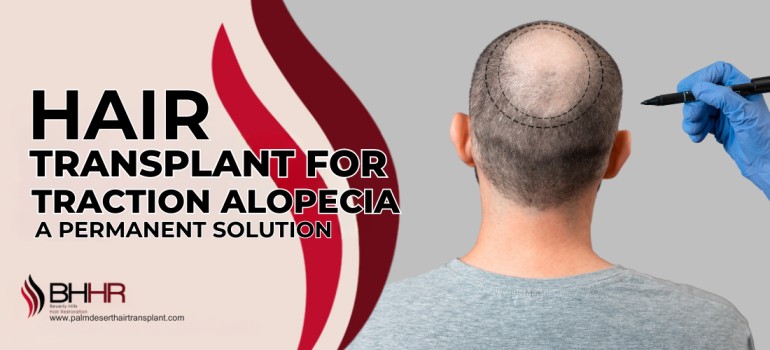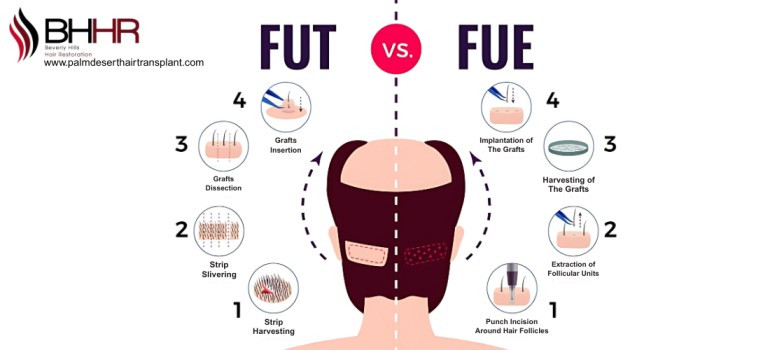Hair Transplant for Traction Alopecia: A Permanent Solution
Home / Hair Transplant / Hair Transplant for Traction Alopecia: A Permanent Solution
Updated On : December 12, 2025 | Category : Hair Transplant | Author: Beverly Hills Hair Restoration Team

Losing hair along your edges or hairline can feel like a slow, silent battle, especially when hairstyles you once wore with pride cause it. This hair loss, called traction alopecia, happens when constant pulling on the hair damages the follicles. At first, it may look like thinning, but the loss can become permanent if the tension continues. And while it’s a physical change, the emotional impact can run even deeper. If you’ve been living with thinning edges, bald patches, or a receding hairline from years of tight styles, you might wonder if there’s a way to bring your hair and confidence back for good.
Summary:
A hair transplant for traction alopecia is a permanent solution that restores thinning edges and receding hairlines caused by long-term tension on the scalp. While early cases can improve with gentler styling and topical treatments, severe or permanent hair loss often requires surgery for lasting, natural results.
What Is Traction Alopecia and Why Does It Happen?
Traction alopecia happens when hairstyles that pull the hair too tightly put stress on the follicles. With time, this constant strain can thin the hair and, if ignored, may even lead to scarring.
Common causes include:
- Hairstyles that pull the hair tightly—like braids, cornrows, or high ponytails
- Heavy wigs, weaves, or clip-in extensions
- Constant use of rollers, headbands, or hair adhesives
Early signs often appear along the temples or forehead, with bumps, redness, or thinning hair. If the traction continues for years, the follicles can die, and regrowth becomes unlikely without surgical intervention.
Can a Hair Transplant Reverse Traction Alopecia?
Yes—hair can grow back. The first step is to stop the damaging habits. Switching to looser styles, using scalp treatments, or applying minoxidil (a topical solution) can help if the follicles are still alive.
But in long-term or severe cases, where bald patches have formed or the scalp looks shiny and smooth, the follicles are usually no longer functional. At this point, the most effective option becomes hair transplant surgery.
Why Hair Transplant Surgery Is the Most Reliable Solution for Traction Alopecia
When your follicles are permanently damaged or scarred, other treatments like oils, serums, or vitamins won't bring the hair back. This is where a hair transplant comes in.
In a hair transplant for traction alopecia, healthy follicles are carefully taken from areas of the scalp where hair is naturally fuller—usually the back or sides—and placed into the thinning or bald spots. Once these follicles take root, the hair grows just like the remains of your natural hair.
What makes this treatment effective is:
- It restores your growing hair, not temporary solutions.
- The results are long-lasting.
- You can style your hair freely and confidently.
- It recreates a natural, fuller hairline.
Which Hair Transplant Technique Works Best for Edges?
The two most trusted techniques in modern hair restoration are FUE (Follicular Unit Extraction) and FUT (Follicular Unit Transplantation). Both have been refined over years of clinical use and are widely practised by Dr. Kahen, a board-certified hair transplant surgeon, worldwide.
-
Follicular Unit Extraction (FUE)
FUE is a less invasive procedure in which individual hairs are extracted one by one from the donor area, usually the back or sides of the scalp, and transplanted into the thinning or balding areas.
Why Specialists Recommend FUE for Traction Alopecia:
- It does not leave a linear scar, which can be great for someone who desires to wear their hair short or who demands to restore their hair to their face or around the temple area.
- It provides precise placement with a natural appearance, and can be crafted to match facial symmetry to a flattering hairline.
- Recovery is often faster, with less pain, and visual healing occurs in a few days.
At BHHR in Palm Desert, FUE is often the preferred choice for restoring thinning edges or receding frontal hairlines caused by traction alopecia. This method delivers natural, seamless results when performed by experienced surgeons.
-
Follicular Unit Transplantation (FUT)
In a FUT hair transplant, a surgeon removes a thin strip of scalp from the back of the head where hair is naturally fuller. That strip is divided into small grafts and placed in the thinning areas. This method is usually chosen by patients who need many grafts done at once.
Why FUT is still trusted in clinical practice:
- It allows for greater graft yield, which is useful for patients with widespread thinning.
- It can be more efficient and cost-effective in specific cases.
- The scar is easily hidden under longer hair.
Dr. John Kahen, with advanced experience in both techniques, often makes personalised recommendations based on scalp health, hair density, and the pattern of hair loss.
Am I a Good Candidate for Hair Transplant Surgery for Traction Alopecia?
Not everyone qualifies for a hair transplant. To be a good candidate, you should:
- Have enough healthy hair in the donor area
- Show signs of permanent traction alopecia (scarring or no regrowth)
- Be in good overall health
- Be ready to change your styling habits
You will need to schedule an appointment with our hair restoration specialist who can assess your candidacy. They’ll evaluate the condition of your scalp, talk through your hair history and design a plan that fits your particular pattern of loss.
What to Expect Before, During, and After Hair Transplant Recovery
At our hair transplant clinic, every patient goes through a clear and comfortable journey. Here’s what you can expect:
Before Surgery
- A thorough scalp assessment and personalized hairline planning
- Pre-op instructions, including stopping certain medications and avoiding smoking for better healing
During Surgery
- Local anesthesia is given to keep you comfortable
- Hair grafts are carefully removed and placed to create a natural-looking hairline
- The process can take 4–8 hours, depending on graft count
After Surgery
- Mild swelling or redness may appear for a few days
- Small scabs form around the grafts, which naturally fall off
- Most patients are back to work within 3–5 days
Hair Growth Timeline
- Transplanted hair may shed in the first 2–3 weeks (a normal part of the process)
- New hair growth typically begins around 3–4 months
- Full results are generally visible by 12 months
How to Maintain Your Results Long-Term
Getting a hair transplant is just one part of the journey. To keep your results:
- Avoid tight hairstyles forever
- Use gentle shampoos and conditioners
- Nourish your scalp with proper hydration and care
- Follow all post-op instructions from doctor
Consistency is key. Protect your new follicles the way you wish you had before the hair loss started.
Start Your Journey to Natural, Permanent Hair Regrowth
Living with thinning edges or bald patches caused by traction alopecia can affect more than just your appearance—it can impact your confidence, too. At our hair transplant clinic, we specialise in advanced Smart FUE and Smart FUT techniques designed to restore natural hairlines and long-lasting results. Every treatment plan is personalised to your scalp health, hair density, and styling goals, ensuring a natural outcome that fits your lifestyle.
Call us at 760.501.0080 to Book your free consultation today and take the first step toward permanent, natural-looking hair restoration. Your new hairline—and confidence—can start here.
About the Author
Dr. John Kahen is a board-certified hair transplant surgeon with over 17 years of expertise in hairline restoration and advanced hair transplant techniques. He has helped countless patients reverse traction alopecia and regain confidence with personalised treatment plans. He leads the expert team at Beverly Hills Hair Restoration in Palm Desert, a clinic known for innovative, patient-focused hair restoration solutions.



